We recently wrote a follow blog post summarizing this
@amjsoc.bsky.social
article. Please follow this link to read more: blogs.lse.ac.uk/usappblog/20...
22.09.2025 23:21 — 👍 5 🔁 0 💬 0 📌 0
#academicsky
04.09.2025 22:29 — 👍 2 🔁 0 💬 0 📌 0
Thanks @shugars.bsky.social !!!
14.08.2025 14:33 — 👍 1 🔁 0 💬 0 📌 0
the USA built a system of higher education so good that smart/rich people from across the world came here, spending billions to learn here, subsidizing education for Americans while spending money to live in our cities and towns. our government arbitrarily decided we should stop doing that
03.08.2025 15:39 — 👍 4079 🔁 1366 💬 65 📌 58
Thank you @thomasdavidson.bsky.social and Danny Karell for all your hard work on this! Really thankful to have been a part of this special issue!
01.08.2025 16:29 — 👍 3 🔁 0 💬 0 📌 0
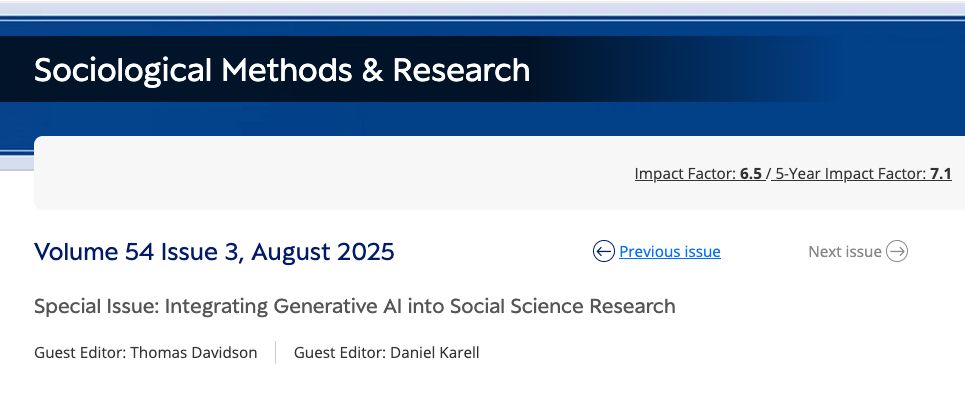
A screenshot of the Sociological Methods & Research website showing the special issue title
I’m delighted to share that the August 2025 special issue of Sociological Methods & Research on Generative AI is out now. Along with my co-editor, Daniel Karell, we put together this issue to build on the conference we organized last year.
Here's a thread on each of the ten papers:
01.08.2025 14:53 — 👍 76 🔁 31 💬 3 📌 5
Thank you for fighting for our public land @wyden.senate.gov !
24.06.2025 17:31 — 👍 1 🔁 0 💬 0 📌 0
Apply - Interfolio
{{$ctrl.$state.data.pageTitle}} - Apply - Interfolio
✨New✨ postdoc opportunity to collaborate with @mollycopeland.bsky.social and myself on an exciting project on geography, community, and mental health at @ndsociology.bsky.social. Happy to talk to anyone interested. Please resky (or whatever retweeting is called here)!
apply.interfolio.com/169206
16.06.2025 18:08 — 👍 7 🔁 9 💬 0 📌 1
our sources included Russian, English, and Ukrainian
18.06.2025 21:28 — 👍 0 🔁 0 💬 1 📌 0
Excited to share “Quantifying Narrative Similarity Across Languages” was just published! Amazing work by my wonderful coauthors — read more below!
18.06.2025 18:22 — 👍 3 🔁 1 💬 1 📌 0
and by you!! @jasong.bsky.social really enjoyed working with you on this paper
18.06.2025 18:24 — 👍 1 🔁 0 💬 0 📌 0
Our replication package is available at this link: doi.org/10.7910/DVN/...
18.06.2025 15:56 — 👍 0 🔁 0 💬 0 📌 0
This article will appear in print in the August SMR special issue on generative AI. Special thanks to Daniel Karell and @thomasdavidson.bsky.social for organizing this special issue! All the articles in the issue are fantastic, please read them all.
18.06.2025 15:56 — 👍 1 🔁 0 💬 1 📌 0
Our paper shows that large language models can be used for complex labeling tasks unattainable by previous measures. We furthermore find fine tuning to hold particular promise for these types of tasks. We also provide a framework for out-of-sample validation of our rare event estimand.
18.06.2025 15:56 — 👍 1 🔁 0 💬 1 📌 0
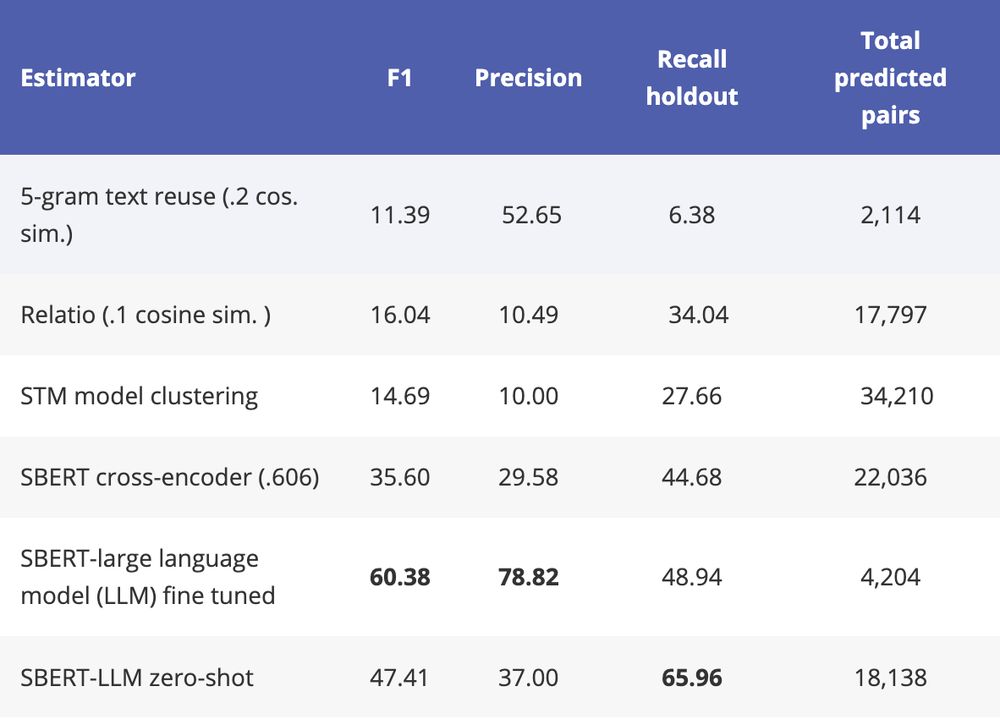
The column recall holdout estimates the percent of 47 holdout pairs recovered by each estimator. The Precision score is the percent of predicted (out of sample) positive cases which were labeled as TPs by human coders. The F1 score is the harmonic mean of two scores. The column total predicted pairs includes the total number of pairs each estimator predicted to be “same claim, same subject” pairs. The bolded estimates indicate the highest performing estimators across all types by metric.
We benchmarked the performance of our approach against a range of existing measures of related estimands. Our measure outperformed these relevant alternatives. We show the performance of our large language model estimators (“SBERT-LLM”) versus considered alternatives in the table below.
18.06.2025 15:56 — 👍 0 🔁 0 💬 1 📌 0
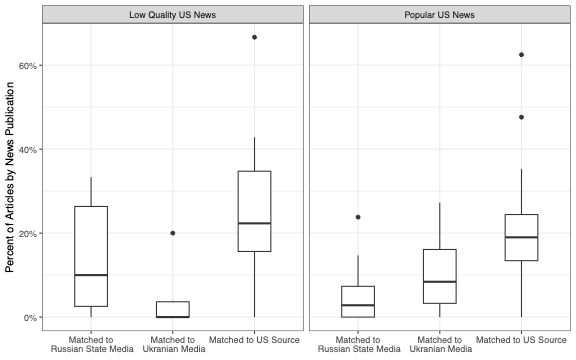
Among U.S. media outlets, the percent articles in our bioweapons corpus that share narratives with Russian state media, Ukranian media outlets, and other U.S. sources. Low quality U.S. media websites (left) are more likely than mainstream popular U.S. news sources (right) to print stories that contain the same narratives as Russian state media articles.
We use this method in a case study of U.S. news website coverage of the war in Ukraine. We show that low quality U.S. news sites were more likely than mainstream U.S. news sites to have overlapping claims (narrative similarity) with Russian newspapers.
18.06.2025 15:56 — 👍 0 🔁 0 💬 1 📌 0
We leverage recent advances in NLP to measure whether two newspaper articles are making the same claims about the same underlying subjects. We use document embeddings to reduce the number of comparisons to a tractable number and large language models for pair annotation.
18.06.2025 15:56 — 👍 0 🔁 0 💬 1 📌 0
Researchers are often interested in tracking the flow of ideas and claims across texts. This is a very challenging target to estimate, however, as due to copyright and journalistic norms authors will often reuse information and ideas without using the same words, phrases or even language.
18.06.2025 15:56 — 👍 0 🔁 0 💬 1 📌 0
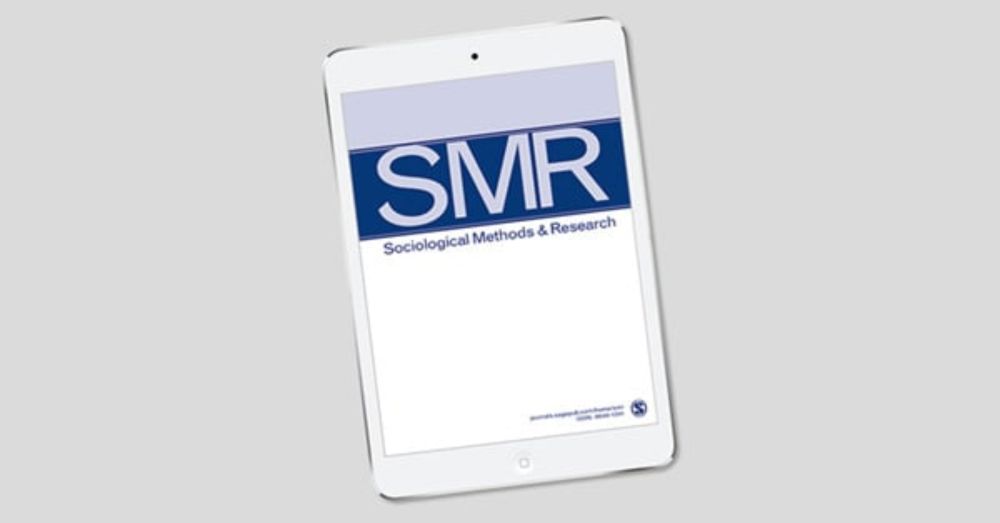
Quantifying Narrative Similarity Across Languages - Hannah Waight, Solomon Messing, Anton Shirikov, Margaret E. Roberts, Jonathan Nagler, Jason Greenfield, Megan A. Brown, Kevin Aslett, Joshua A. Tuck...
How can one understand the spread of ideas across text data? This is a key measurement problem in sociological inquiry, from the study of how interest groups sh...
I am thrilled to share a new article in Sociological Methods & Research, “Quantifying Narrative Similarity Across Languages”. My co-first author Sol Messing and our collaborators developed a new approach to measuring “narrative similarity” between texts: journals.sagepub.com/doi/10.1177/...
18.06.2025 15:56 — 👍 57 🔁 27 💬 3 📌 4
Thanks Erik!
11.06.2025 18:30 — 👍 1 🔁 0 💬 0 📌 0
Excellent new work by one of our graduate students
07.06.2025 18:36 — 👍 1 🔁 0 💬 0 📌 0
Read the first article from the ASA Sex & Sexualities Section's new journal, in which editors Krystale E. Littlejohn @drklittlej.bsky.social, U of Oregon, & Amy L. Stone @amylstone1.bsky.social, Trinity University, consider the importance of nurturing a sociology of sex & sexualities. bit.ly/3EyV56r
22.04.2025 20:22 — 👍 6 🔁 4 💬 0 📌 0
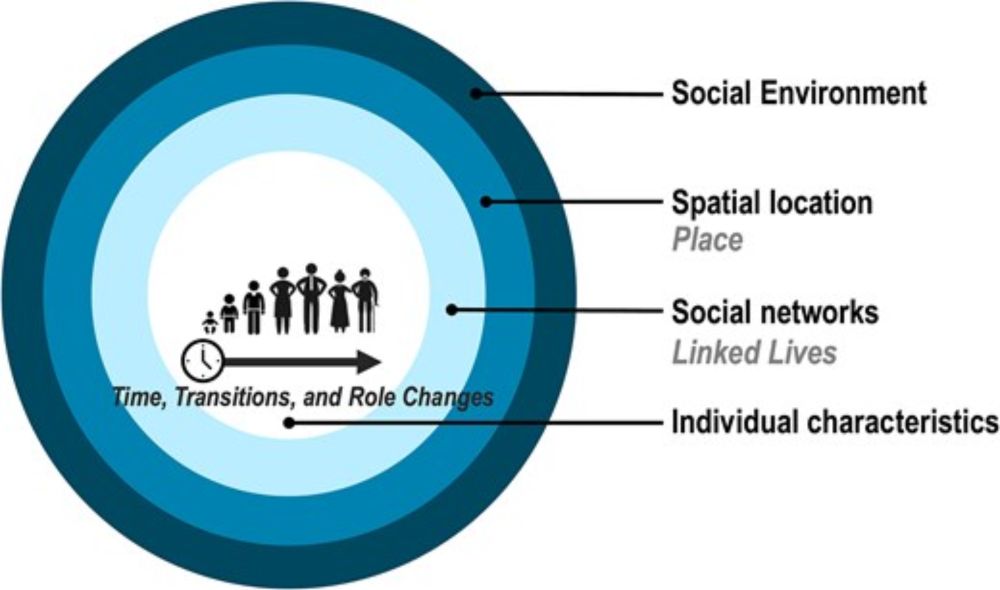
Life course illegality: how the life course and aging shape the experience of illegality
Abstract. Scholars have studied in detail how immigrants experience illegality in the US. Many have focused on immigrants’ fear of deportation as central t
📣🚨 NEW ARTICLE: Many #immigrants are aging & remain undocumented. What is their experience of illegality as they age–specifically their fear of deportation? New publication @sfjournal.bsky.social! Please read and share widely. 🔗 here: bit.ly/SF25-LCI (summary below) /1
04.06.2025 22:29 — 👍 24 🔁 10 💬 2 📌 0
The Polarization of Inequality Perceptions in the New Gilded Age | American Journal of Sociology: Vol 0, No ja
Hannah Waight and Adam Goldstein show that inequality perceptions have become increasingly polarized by partisanship.This gap has been driven by Republicans, whose increasing disavowal of growing inequality contributed to an overall decline in Americans’ perceptions in the new gilded age.
02.06.2025 19:08 — 👍 4 🔁 1 💬 0 📌 1
Elite political polarization on distributional matters proceeded mass partisan polarization. We show this by examining data on Democratic and Republican party platforms from the Comparative Manifestos Project.
02.06.2025 00:52 — 👍 1 🔁 0 💬 0 📌 0
Given the cross sectional nature of our data it is beyond the scope of our data to directly identify the cause of Republicans' asymmetrical downturn. We discuss in the conclusion, however, that one likely possibility was elite signaling.
02.06.2025 00:52 — 👍 1 🔁 0 💬 1 📌 0
Thank you @jonathanmijs.com we were very inspired by your work on how people perceive social structure!
02.06.2025 00:36 — 👍 1 🔁 0 💬 0 📌 0
Assistant Prof at UChicago | Sociologist | Columnist @Inthesetimesmag.bsky.social | Co-author of revolutionary sci-fi novel: Everything for Everyone | Subject of documentary film "Coming Around"
Princeton Sociology Prof; ethnographer of NASA; tech policy; digitalSTS; ethics and critical technical practice; mobile Linux. Conscientious objector to personal data economy.
https://janet.vertesi.com
https://www.optoutproject.net
@cyberlyra@hachyderm.io
investigative journalist @correctiv.org • currently Burns Fellow with @propublica.org • Signal: tilleckert.90 🔦
tilleckert.com
New Yorker staff writer and Houston Rockets fan.
Teaching and writing media studies at CU Boulder. Helping to build a cooperative fediverse with Social.coop. Fan of democratic experiences and divine mysteries. Co-leading metagov.org, start.coop, wagingnonviolence.org.
Associate Professor of Sociology. Medical Sociology. Health Disparities. 🔮
Senior Correspondent at Vox covering the crisis of global democracy. Author of The Reactionary Spirit, a book on that topic, and a '25-'26 distinguished visiting fellow at the University of Pennsylvania's Perry World House.
Professor, researcher, author.
VP Association of Internet Researchers, synth lover, fan of many things, gay lady.
Wrote a book called Behind the Screen: Content Moderation in the Shadows of Social Media (Yale 2019), and Meta stole it to train its LLM.
We are a multidisciplinary research centre based @royalholloway.bsky.social. We use computational methods and big data to investigate the role of social media platforms in politics, in partnership with key stakeholders and policymakers.
Founder, Author, Engineer. I live and breathe Data Science, Network Science, Natural Language Processing, Artificial Intelligence, Machine Learning, Cybersecurity, and more.
https://100daysofnetworks.substack.com
https://ko-fi.com/davidknickerbocker
Political Scientist - NYU
Writer. Never bet against the dumbest outcome. @cwarzel.92 on signal if you have a tip
Stendahl Chair at Harvard Divinity School / studying demons, apocalypses, and ancient identities, between memory and forgetting
Sociology PhD Student @Yale
All things K-12 education policy. Professor @PrincetonSPIA & Sociology; Director, Education Research Section.
Career teacher, education prof, teacher union activist. Researcher, writer, in the struggle for social justice, union democracy. Socialist. https://loisweiner.net/ and https://futureschools.substack.com/
History (Ottoman and Russian Empires) and international law.
Author, "From Slaves to Prisoners of War" (Oxford, 2018) and co-author, "To Save the Country" (Yale, 2019).
All views strictly my own.
Electrochemist at the University of Oregon and Director of the Electrochemistry Masters Internship Program. Leading a team researching electrochemical solutions for deep decarbonization.
kempler.uoregon.edu | electrochemistry.uoregon.edu/
Mathematician, University of Oregon.







